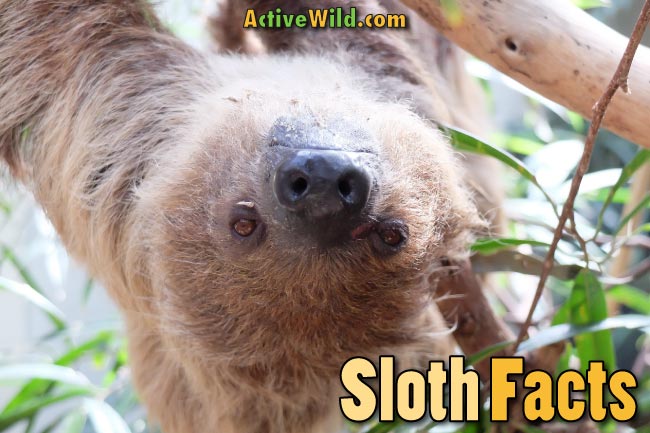

They have reduced muscles, about half the relative weight of most terrestrial mammals, so they cannot afford to keep warm by shivering. Everything is sluggish and slow-moving, even food digestion 3. Sloths have a metabolic rate that is only 40 to 45 percent of what would be expected for their body weight. There are 2 groups of sloth in the world 2. Sloths maintain a low, but variable body temperature that ranges from 86 to 93 degrees Fahrenheit (30 to 34 C), which falls during cooler hours of the night, in wet weather, and whenever the animals are inactive. Their hair curves from stomach toward their back this is opposite from most mammals. Their fur also harbors moths, ticks and beetles. Sloths can hold their breath for almost 40 minutes When you learn how long sloths can hold their breath, they start looking like adorable slow-moving oxygen tanks But, all kidding aside, it’s true that these slow animals can hold their breath for a whopping 40 minutes at a time. This greenish tint camouflages them in the forest canopy. They possess a short, fine undercoat, and an overcoat of longer, coarser hairs, which turn green in moist conditions due to algae growth.Įach strand of brownish-gray hair has grooves running from top to bottom, where two species of blue-green algae grow. The head is short and flat, with a snub nose, rudimentary ears, and large eyes. 15 Facts About Sloths - Learn All About Sloths - Animals for Kids - Educational Video animal fun facts 6.94K subscribers Subscribe 64 Share 19K views 1 year ago Everything you want to know about. They are threatened by habitat loss and are sometimes captured for use in performances or hunted because of their aggressive behavior and destruction of crops.A sloth's body consists of a short neck with four long limbs of equal length, ending in two 3 to 4 inch (8 to 10 centimeter) long curved claws. Sloth bears are considered vulnerable animals. The cubs will often ride on their mother’s back, a unique trait among bears. ReproductionĪfter a six- to seven-month gestation period sloth bears normally give birth to a litter of two cubs in an underground den. They wear an extremely shaggy black coat and a cream-colored snout, and their chest is usually marked with a whitish “V” or “Y” design. When threatened they respond by standing on their hind legs and displaying their formidable foreclaws. They grow up to 6 feet in length, and males can weigh up to 310 pounds, while females weigh up to 210 pounds. 21 Sloth Facts For Kids Sloth is the common name for several tree dwelling mammals in the Pilosa order and Folivora suborder. Sloths have an exceptionally low metabolic rate and spend 15 to 20 hours per day sleeping. These bears have a naturally long life, living for 20-30 years in the wild. According to the IUCN Red List, the pygmy three-toed sloth is Critically Endangered, while the maned sloth is considered Vulnerable.

They move through the canopy at a rate of about 40 yards per day, munching on leaves, twigs and buds. There are six sloth species, out of which two are considered endangered species. Sloth bears are solitary creatures and generally nocturnal. spend their lives in the tropical rain forests. It is this habit that’s given rise to their nickname, honey bears.

They are also known to scale the occasional tree to knock down a bee honeycomb, which they will then enjoy on the ground below. They move very little and expend very little energy. They mostly live alone in shrubby vegetation like. As a result, the energy they get from food is insufficient compared to other mammals of about the same size. Adult sloths weigh anywhere between 9 and 17 pounds and on average stand about 3 feet high, but specific measurements depend on the species. To do so, they close their nostrils and use their lips like a vacuum nozzle.īeyond insects, sloth bears feast on a variety of fruit and flowers, including mango, fig, and ebony. Sloths have a very low metabolic rate Sloths generally eat tree leaves and insects. Once they’ve opened a hole, they blow away excess dirt then noisily suck out the insects through a gap in their front teeth. Their long, curved claws are used for penetrating nest mounds, which can be rock-hard. Sloth bears feed predominantly on termites and ants and employ a well-evolved method to dig them out. Emitting noisy grunts and snorts, it wanders alone, usually at night, in search of insects and fresh fruit. Shaggy, dusty, and unkempt, the reclusive sloth bear makes its home in the forests of South Asia.


 0 kommentar(er)
0 kommentar(er)
